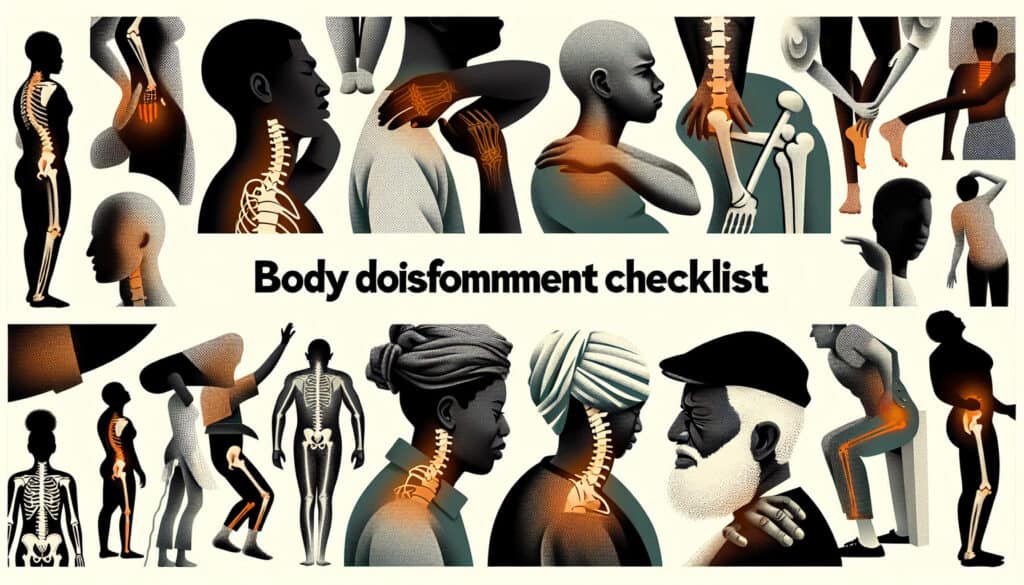A checklist used to identify and assess the level of discomfort in different parts of the body.
- Méthodologies : Lean Sigma, Fabrication
Body Discomfort Checklist

Body Discomfort Checklist
- Amélioration continue, Ergonomie, Facteurs humains, Ingénierie des facteurs humains (HFE), Amélioration des processus, Gestion des risques, Safety
Objectif :
Comment il est utilisé :
- Body discomfort checklists are used in ergonomics and occupational health to identify and assess the risk of musculoskeletal disorders.
Avantages
- Is a simple and easy-to-use tool for assessing body discomfort, can be used to identify high-risk tasks and postures, and can be used to track the effectiveness of ergonomic interventions.
Inconvénients
- Is a subjective measure of discomfort, the results can be influenced by a number of factors, such as motivation and fatigue, and the checklist may not be suitable for all types of tasks.
Catégories :
- Ergonomie, Ressources humaines
Idéal pour :
- Assessing body discomfort to identify and manage the risk of musculoskeletal disorders.
The Body Discomfort Checklist finds significant application within sectors such as manufacturing, healthcare, transportation, and office environments, where workers frequently engage in repetitive tasks or maintain static body postures for extended periods. By facilitating the systematic identification of body discomfort, this tool assists design engineers, human factors specialists, and occupational health professionals in evaluating jobs that may lead to musculoskeletal issues. During the early stages of product design, when assessing workstations or tools, incorporating the Body Discomfort Checklist can provide valuable data that informs modifications aimed at reducing strain. Participants typically include employees who directly perform the tasks, ergonomics practitioners, and safety officers who analyze the findings to devise actionable strategies. Regularly utilizing this checklist allows organizations to monitor ergonomic interventions’ effectiveness, which can further enhance employee well-being and productivity while reducing compensation costs associated with work-related injuries. In particular, when combined with other ergonomics assessments and observational methodologies, the checklist can yield comprehensive insights into workplace dynamics, promoting a culture focused on health and safety amidst continuous operational improvements.
Principales étapes de cette méthodologie
- Identify specific tasks and postures associated with body discomfort.
- Utilize the checklist to evaluate body areas affected by discomfort during work activities.
- Assess the frequency and intensity of reported discomfort for each identified task or posture.
- Prioritize tasks based on the severity of discomfort reported by individuals.
- Implement ergonomic interventions targeting high-risk tasks and postures.
- Re-evaluate discomfort using the checklist post-intervention to determine effectiveness.
Conseils de pro
- Incorporate feedback loops in the checklist process, allowing workers to share experiences regarding discomfort, which can provide valuable qualitative data on task-specific issues.
- Integrate technology, such as portable sensors, to supplement the checklist data, offering real-time monitoring and objective metrics on posture and movement patterns.
- Regularly update and validate your checklist against the latest research in ergonomics and musculoskeletal disorders to ensure its relevance and accuracy in different work environments.
Lire et comparer plusieurs méthodologies, nous recommandons le
> Référentiel méthodologique étendu <
ainsi que plus de 400 autres méthodologies.
Vos commentaires sur cette méthodologie ou des informations supplémentaires sont les bienvenus sur le site web de la Commission européenne. section des commentaires ci-dessous ↓ , ainsi que toute idée ou lien en rapport avec l'ingénierie.
Contexte historique
1986
(si la date est inconnue ou n'est pas pertinente, par exemple "mécanique des fluides", une estimation arrondie de son émergence notable est fournie)

Articles Similaires
Gestion des opérations de fabrication (MOM)
Système d'exécution de la fabrication (MES)
Plan de contrôle de la fabrication
Tests manuels
Tableaux d'évaluation des manutentions manuelles (MAC)
ManTRA (outil d'évaluation des risques liés aux tâches manuelles)